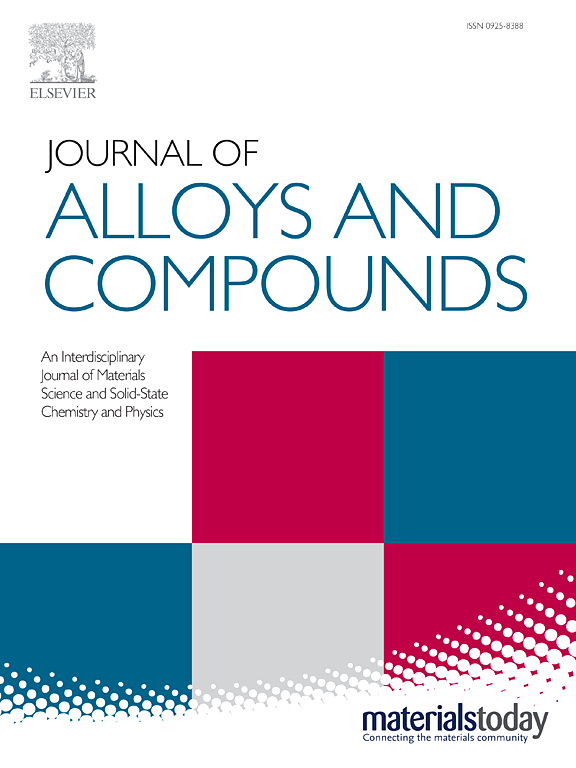Microstructure and mechanical properties evolution of a novel selective laser melted Al-Cu-Ni-Zr-Ti alloy during heat treatment
IF 6.3
2区 材料科学
Q2 CHEMISTRY, PHYSICAL
引用次数: 0
Abstract
This study presents the microstructure and mechanical properties of an additive manufactured Al-Cu-Ni-Zr-Ti alloy fabricated by selective laser melting (SLM). The microstructure evolution during heat treatment at elevated temperatures and its impact on the mechanical properties were also systematically investigated. Results showed that the as-built Al-Cu-Ni-Zr-Ti alloy exhibited a heterogeneous grain structure, which consisted of ultrafine equiaxed and columnar grains at the bottom and top of molten pool, respectively. The L12-Al3(Zr, Ti) phase tends to form within the grains, while the heat-resistant Al7Cu4Ni phase preferentially distributes along grain boundaries during the SLM process. As a result, the SLMed Al-Cu-Ni-Zr-Ti alloy, with these unique heterogeneous structures, displays high strength and good heat resistance. The yield strength and elongation of the as-built alloy were measured as 278 MPa and 7 %, respectively. When the alloy is exposed to 300 °C and 350 °C, the yield strength gradually improved with the time extended from 3 h to 200 h. Particularly, after exposure to 350 °C for 200 h, the yield strength reached 310.8 MPa, which is 12 % higher than the as-built condition (278.3 MPa). Microstructure observation revealed that the refined Al7Cu4Ni phase and grains exhibited good coarsening resistance during exposure at 300 °C and 350 °C, precipitation of nano-sized L12-Al3(Zr, Ti) and θ' phases provide additional strengthening. Therefore, the SLMed cost-effective Al-Cu-Ni-Zr-Ti alloy demonstrates promising suitability as a heat-resistant aluminum alloy within the 300–350°C range, while its thermal resistance at temperatures up to 400°C remains insufficient.
一种新型选择性激光熔化Al-Cu-Ni-Zr-Ti合金热处理过程中的组织和力学性能演变
研究了选择性激光熔化(SLM)添加剂制备Al-Cu-Ni-Zr-Ti合金的显微组织和力学性能。系统地研究了高温热处理过程中的组织演变及其对力学性能的影响。结果表明:铸态Al-Cu-Ni-Zr-Ti合金呈非均匀晶粒结构,熔池底部和顶部分别由超细等轴晶和柱状晶组成;在SLM过程中,L12-Al3(Zr, Ti)相倾向于在晶粒内部形成,而耐热Al7Cu4Ni相优先沿晶界分布。结果表明,具有这些独特非均相组织的SLMed Al-Cu-Ni-Zr-Ti合金具有高强度和良好的耐热性。合金的屈服强度和伸长率分别为278 MPa和7%。当合金暴露于300℃和350℃时,屈服强度随着时间的延长逐渐提高,从3 h延长到200 h,特别是在350℃暴露200 h后,屈服强度达到310.8 MPa,比原状(278.3 MPa)提高了12%。显微组织观察表明,在300℃和350℃下,细化的Al7Cu4Ni相和晶粒表现出良好的抗粗化能力,纳米级L12-Al3(Zr, Ti)和θ′相的析出进一步增强。因此,具有成本效益的SLMed Al-Cu-Ni-Zr-Ti合金在300-350°C范围内表现出良好的耐热性,而其在高达400°C的温度下的耐热性仍然不足。
本文章由计算机程序翻译,如有差异,请以英文原文为准。
求助全文
约1分钟内获得全文
求助全文
来源期刊

Journal of Alloys and Compounds
工程技术-材料科学:综合
CiteScore
11.10
自引率
14.50%
发文量
5146
审稿时长
67 days
期刊介绍:
The Journal of Alloys and Compounds is intended to serve as an international medium for the publication of work on solid materials comprising compounds as well as alloys. Its great strength lies in the diversity of discipline which it encompasses, drawing together results from materials science, solid-state chemistry and physics.
 求助内容:
求助内容: 应助结果提醒方式:
应助结果提醒方式:


